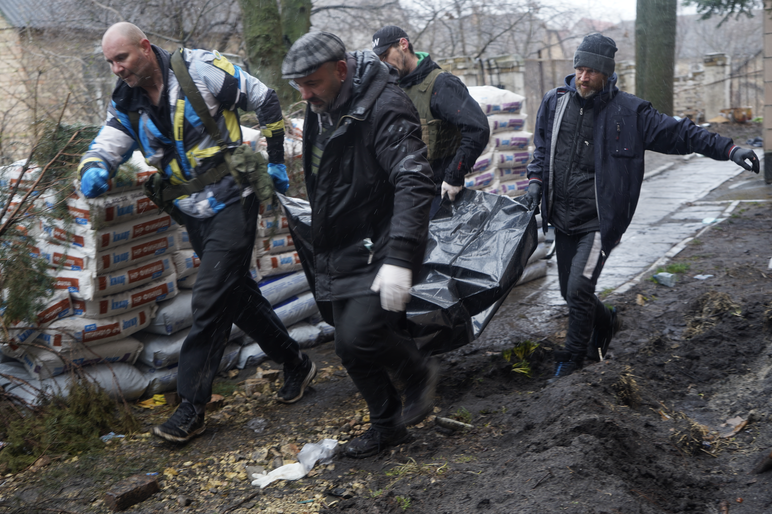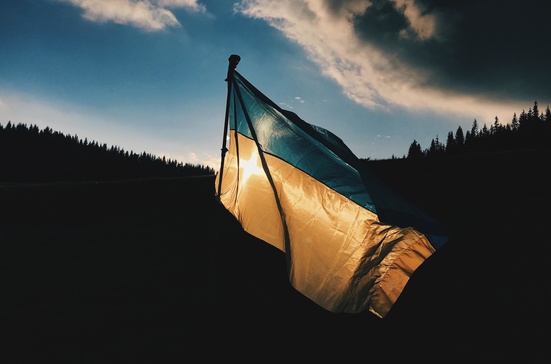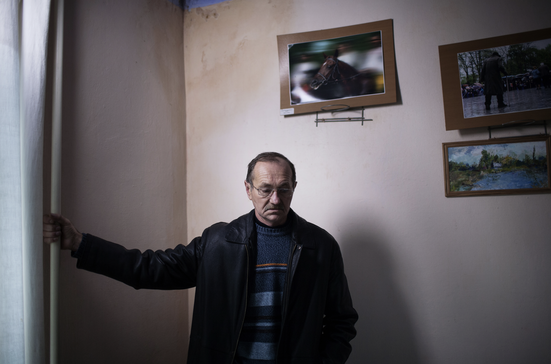Ukraine: killings, kidnappings and torture of civilians in territories under Russian control

Update on the human rights crisis in Ukraine, May 2022
Geneva – Brussels - Kyiv, 6 May 2022 – As the scale of serious human rights violations committed in Ukraine in the context of the armed conflict is increasing, the World Organisation Against Torture (OMCT) and its Ukrainian partners keep documenting cases throughout the country.
Following the re-establishment of Ukrainian control over territories in the central and northern parts of the country in April, the OMCT and its partners were able to document a series of serious human rights violations. These include numerous extrajudicial killings, incommunicado detentions and abductions - in some cases followed by forced displacement to Belarus and Russia -, torture and ill-treatment of detainees and abductees, as well as the ill-treatment of family members of those abducted, during or after their abduction.
The victims of the attacks are civilians whom the Russian military suspected of supporting the Ukrainian army or simply of allegiance to Ukraine. They include a large variety of categories: civic activists and humanitarian aid volunteers; veterans of the 2014 conflict; simple citizens who support the territorial integrity of Ukraine, the Ukrainian army or who sport pro-Ukraine tattoos; or even just random passers-by.
Extrajudicial killings and injuring of civilians
Extrajudicial killings by Russian troops are characterized by the random selection of victims among civilians who were not involved in resisting the Russian invasion. The bodies of murdered civilians have not been handed over to their relatives or properly buried. We could verify at least one incident in which a dead body was deliberately booby-trapped, to hurt those who touch it.
Bucha, Kyiv region. The town of Bucha was under Russian control from March 5 until the night of March 30-31, 2022. Following the restoration of Ukrainian control over Bucha, scores of grave human rights violations came to the surface. Among the dead bodies were those of two civilians whose enforced disappearance had been previously documented by the OMCT and its Ukrainian partners, Vladyslav Korniienko and Denys Butenko. The OMCT also received evidence of the alleged extrajudicial killings of at least four other civilians in Bucha. These six victims are not an estimate of the total number of unlawful killings in Bucha, just cases that the OMCT and its partners were able to directly verify.
On April 13, the body of Bucha resident Vladyslav Korniienko was identified in a mass grave with two bullet wounds. Mr Korniienko's family had no information about his whereabouts after he disappeared on March 6, following a random encounter with two armed Russian soldiers in Bucha. According to his family, Mr Korniienko did not take part in the resistance to the invasion.
On March 9, Denys Butenko, a humanitarian aid volunteer, left his house and never returned. Mr Butenko did not take his mobile phone with him, so his family assumes that he did not plan to go far. On April 18, Denys Butenko's body was found in a forest belt between the towns of Vorsel and Bucha, with five gunshot wounds to the neck, chest and abdomen. Ukrainian law enforcement authorities have confirmed that he was killed on March 9. According to Mr Butenko's relatives, after Russian troops established control over Bucha, the volunteer delivered food to residents and donated blood for injured civilians.
Witnesses reported that in a second deployment, Russian troops took control of the area of Yablunska street, and prohibited locals from leaving their homes, threatening to shoot anyone who disobeyed, but without properly informing the population. One of the OMCT’s witnesses reported that a Russian patrol threatened him with a machine gun on Yablunska Street. He was later released but the soldiers told him they would throw grenades at his house if he was spotted in town again.
A Russian soldier entered the basement, said that his commander had ordered him to shoot four people and offered the detainees to choose who should be shot.
Novy Bykov village, Chernihiv region. Stary Bykov and Novy Bykov villages were under Russian control from February 27 to March 30, 2022. The OMCT documented widespread arbitrary detentions of civilians. Before withdrawing, the Russian military raided the homes of residents, checking their phones and abducting those they suspected of sympathizing with the Ukrainian army, together with their family members.
The Russian military held 24 local civilians in the basement of the House of Culture in Novy Bykov, where they had established their headquarters. On March 30, a Russian soldier entered the basement, said that his commander had ordered him to shoot four people and offered the detainees to choose who should be shot. Two men volunteered. To choose the other two, the Russian soldier forced the detainees to draw lots. The bodies of the four men were later found near the village cemetery. The remaining 20 prisoners were released after the withdrawal of the Russian army.
Kherson. The city of Kherson has been under the control of the Russian army since March 1st. A resident reported to the OMСT that he witnessed the Russian military use violence against peaceful demonstrators who were protesting against the occupation on Freedom Square on March 3, 13, 21, and 22.
On March 21, the Russian military threw stun grenades at protesters without any prior warning, used tear gas, and fired in the air. At least one person was injured in the leg by grenade shrapnel. Two Russian soldiers kicked another civilian in the face, while another one held the man to the ground. A witness reported that he saw at least two other civilians being taken away by ambulances and several more being provided medical assistance on the spot.
On March 22, the office of the Russian commander in Kherson announced that any peaceful rallies in the city would be forbidden. On that day, the Russian military once again threw stun grenades at the crowd of peaceful protesters. Witnesses saw several demonstrators being detained, while at least one person was taken by an ambulance. The OMCT also received credible information about the detention and subsequent physical aggression of a passerby who was taking pictures of the rally.
Arbitrary detentions and enforced disappearances of civiс activists, veterans of the military operation in eastern Ukraine, and other civilians suspected of disloyalty by the Russian military continue in Kherson.
Enforced disappearances and related torture and ill-treatment
Ukrainian human rights organisations have received information about hundreds of cases of enforced disappearances. Numbers go from the 293 cases recorded by the Center for Civil Liberties (as of April 29, 2022) to the 139 cases documented as of April 29 by the Human Rights Centre ZMINA, the Media Initiative for Human Rights, and the Crimean Human Rights Group. The highest number of cases are reported in the Kyiv, Kherson and Zaporizhzhia regions.
From February 24 to April 30, the OMCT and its Ukrainian partners have directly documented 16 alleged enforced disappearances in the Kherson, Kyiv, Zaporizhzhia, Mykolaiv, and Chernihiv regions, all of which are or were under Russian control. The OMCT has submitted communications on all of these cases to the United Nations Working Group on Enforced or Involuntary Disappearances (WGEID).
- In six cases, relatives still do not have any official or unofficial information on the whereabouts of the victims.
- Four of the victims the OMCT mentioned in the previous crisis updates were released (Oleg Baturin, Viktor Maruniak, Dmytro Bodyu, and Serhiy Pryima). The relatives of these victims had no information about them for up to 45 days. The OMCT has confirmed that at least two of them (Oleg Baturin and Viktor Maruniak) had been subjected to torture and ill-treatment by Russian military personnel or intelligence agencies.
In one case, the family learnt about the man's transfer to Russia through a news piece on Russian television
As stated above, two victims were found dead with gunshot wounds (Vladyslav Korniienko and Denys Butenko) after relatives had not heard from them for more than a month.
In four cases, the families were informed by people who had been released as part of prisoner exchanges that their relatives had been taken to detention facilities in the Bryansk and Kursk regions of Russia. In one of the cases, an independent lawyer was not allowed to visit the defendant in the pre-trial detention centre in Russia, with the administration even refusing to confirm his detention. The OMCT has also confirmed several cases of torture against abducted Ukrainian civilians in pre-trial detention centre № 2 of Novozybkov town, Bryansk region.
Moreover, in the case of Serhiy Tsyhipa, the family learnt about his transfer to Russia through a news piece on Russian television, in which the abducted man was shown defending Russian official arguments. His relatives are convinced he was speaking under duress.
In all four cases, the families have still not received any official information from Russia regarding the location and state of health of their relatives.
The persons abducted fall under the following three categories:
- local government representatives, local activists and opinion leaders who openly opposed the occupation and refused to cooperate with the Russian troops (eight people)
- humanitarian aid volunteers who provided food products and evacuation for civilians from the occupied territories (two people)
- ordinary civilians (six people)
The interviews we conducted, as well as the general context in the territories under Russian control, suggest that the objectives of the enforced disappearances of local government representatives, civil activists and humanitarian volunteers are the following: 1) to force victims to cooperate with the Russian troops 2) to take revenge for lack of support to the occupation 3) to prevent any activities, including humanitarian, that are not approved by the occupiers.
Another clear pattern is the enforced disappearance of ordinary civilians by the Russian troops during their withdrawal from the occupied territories or during the transportation of military equipment and personnel through certain territories. In cases in which witnesses were present during enforced disappearances, they reported that the perpetrators were groups of armed military men in balaclavas who behaved aggressively, threatened witnesses and tried to intimidate civilians. The soldiers wore white or red armbands and drove in vehicles marked with a “Z”, a symbol of support to the Russian military.
Several enforced disappearances were presumably carried out by members of Russian intelligence agencies, as witnesses noted the specific manner of communicating, the uniforms that were different from those of the regular Russian military, and the use of special equipment.
Additionally, in two cases (Victoria Andrusha and Mykyta Buzinov), either the victims or the witnesses were subjected to ill-treatment, including mock executions (Mykyta Buzinov) before the abduction took place.
It should also be noted that in some cases, residents who collaborate with the Russian military contacted the victims on the eve of their enforced disappearance, threatening them should they refuse to cooperate with the occupiers.
This update is published based on information collected and verified in cooperation with the Human Rights Centre ZMINA (Kyiv, Ukraine), the Centre for Civil Liberties (Kyiv, Ukraine), the Media Initiative for Human Rights (Kyiv, Ukraine), the Information Resource Centre “Legal Space” (Kherson, Ukraine), the Crimean Human Rights Group (Kyiv, Ukraine).
The World Organisation Against Torture (OMCT) is the largest global NGO group actively standing up to torture and protecting human rights defenders worldwide. It has more than 200 members in 90 countries. Its international Secretariat is based in Geneva, Switzerland.
For more information, please contact :
Iolanda Jaquemet, Director of Communications
ij@omct.org
Mobile +41 79 539 41 06
Tags
Related resources
-
- Russian Federation
- 15.03.22
- Urgent Interventions
 Read more
Read moreUkraine/Russia: Disappearance of Ukrainian journalist Oleg Baturin

